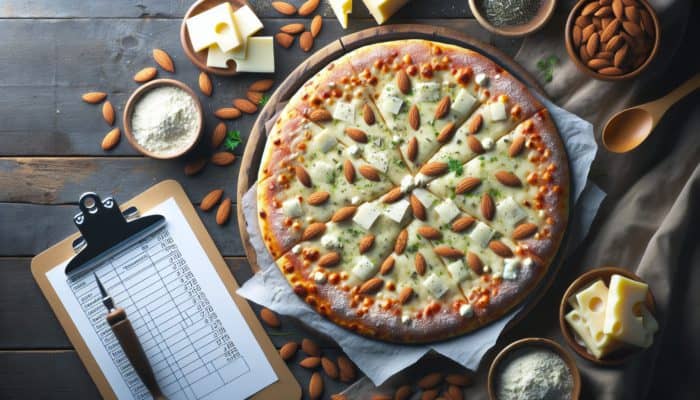Unlock the Culinary Magic of Low-Carb Pizza Dough for Irresistible Dishes
Discover Why Low-Carb Pizza Dough Revolutionizes Your Pizza Experience

The innovative concept of low-carb pizza dough offers a thrilling alternative to conventional pizza bases, meticulously designed for those seeking to lower their carbohydrate intake while relishing scrumptious meals. This groundbreaking culinary approach has gained immense popularity, particularly among individuals adhering to ketogenic diets, which prioritize minimizing carbohydrate consumption to achieve effective weight loss and maintain balanced blood sugar levels. By utilizing alternative flours and unique ingredients, low-carb pizza dough creates a delightful texture and flavor profile, enabling you to enjoy your favorite dishes without the guilt typically associated with high-carb options.
Additionally, the adaptability of low-carb dough opens the door to endless possibilities for crafting various pizza styles, from the classic Margherita to more adventurous toppings that cater to diverse palates. The secret lies in carefully selecting the right combination of ingredients to create a dough that not only excites your taste buds but also accommodates different dietary preferences and restrictions.
Explore the Numerous Health Benefits of Low-Carb Dough
Choosing low-carb dough offers a wide array of advantages, making it an appealing choice for many individuals. One of the primary benefits is its capacity to effectively regulate blood sugar levels. Traditional pizza dough is often packed with refined carbohydrates, which can lead to quick spikes in blood sugar, particularly detrimental for those managing diabetes or experiencing insulin resistance. Low-carb alternatives mitigate this reaction, providing a steadier source of energy throughout the day.
Moreover, integrating low-carb dough into your meals can significantly bolster your weight loss journey. By decreasing carbohydrate consumption, your body may enter a state of ketosis, where it starts burning fat for fuel instead of sugars. This metabolic shift not only facilitates weight loss but can also enhance mental clarity and focus. For those following restrictive diets, low-carb pizza dough offers a satisfying meal option that doesn’t compromise on flavor or enjoyment.
Essential Ingredients for Crafting Low-Carb Pizza Dough
Crafting the ultimate low-carb pizza dough hinges on selecting the right ingredients. Commonly utilized components include almond flour, coconut flour, cheese, and eggs.
- Almond flour: This gluten-free flour is low in carbohydrates while rich in protein and healthy fats, providing a delightful nutty flavor and satisfying texture.
- Coconut flour: A flexible alternative that adds a subtle coconut taste, it is highly absorbent and typically requires more liquid than other flours.
- Cheese: Typically mozzarella or cream cheese, it contributes richness and acts as a binder, enhancing both the flavor and texture of the dough.
- Eggs: Serving as a binding agent, eggs provide structure and moisture, making the dough easier to handle during preparation.
When combined, these ingredients create a dough that is not only low in carbohydrates but also abundant in flavor and enjoyment, paving the way for limitless culinary creativity.
Discover Expert-Approved Top Low-Carb Pizza Dough Recipes

Explore Popular and Successful Low-Carb Pizza Recipes
Within the realm of low-carb pizza dough, numerous recipes have garnered praise from both culinary experts and passionate home cooks. Below is a carefully curated selection of beloved favorites that exemplify the versatility of low-carb ingredients:
- Almond Flour Pizza Crust: Crafted with almond flour, mozzarella cheese, eggs, and seasonings, this crust strikes a delightful balance between heaviness and crispiness.
- Coconut Flour Pizza Base: A blend of coconut flour, eggs, and cheese yields a light base with a subtle coconut essence, ideal for adventurous eaters.
- Cauliflower Pizza Crust: Grated cauliflower combined with cheese and eggs creates a gluten-free, vegetable-packed option that is both nutritious and flavorful.
- Fathead Dough: A popular choice made from almond flour and mozzarella, resulting in a remarkably stretchy and satisfying dough.
These examples showcase the diverse array of ingredients available and illustrate how simple it is to prepare a delightful low-carb pizza base right in your kitchen.
Step-by-Step Guide to Perfectly Prepare Low-Carb Dough
Creating low-carb pizza dough is a straightforward process that anyone can master with a few simple steps. Here’s a practical guide to efficiently prepare your dough:
- Combine the Ingredients: Begin by mixing your chosen flour (almond or coconut), cheese, eggs, and any desired seasonings in a mixing bowl until thoroughly blended.
- Knead the Dough: After mixing, knead the dough until it reaches a smooth consistency, ensuring all components are well incorporated.
- Roll Out the Dough: Transfer the dough to a floured surface and roll it out to your preferred thickness, noting that thinner crusts will yield a crunchier finish.
- Preheat Your Oven: While preparing the dough, preheat your oven to approximately 220°C for optimal baking results.
By adhering to these steps, even novice cooks can achieve remarkable results, crafting a low-carb pizza crust that is both satisfying and adaptable.
Tips for Perfecting the Dough’s Texture and Flavor

The texture and flavor of low-carb pizza dough are pivotal elements that can dramatically influence the overall pizza experience. Achieving the perfect dough necessitates a keen understanding of ingredient balance. For instance, the combination of almond flour and mozzarella cheese results in a slightly chewy texture that closely resembles traditional pizza dough, whereas coconut flour can impart an airy lightness that some individuals may prefer.
To enhance taste, incorporating herbs and spices such as garlic powder or Italian seasoning can significantly elevate the flavor profile. A practical tip is to experiment with different types of cheese; blending in cream cheese can yield a creamier texture, while utilizing a mix of cheeses can provide a more complex flavor experience.
Ultimately, the ideal low-carb pizza dough achieves a harmonious balance between texture and flavor, ensuring that every bite is both enjoyable and delectable.
Customization Options and Variations to Explore
The true beauty of low-carb pizza dough resides in its adaptability, allowing you to cater to various dietary preferences and flavor profiles. The potential for variations and customizations is virtually limitless, enabling you to tailor recipes to your unique tastes.
If you enjoy culinary experimentation, consider adding spices directly into the dough. Incorporating crushed red pepper flakes can deliver a delightful kick, while Italian herbs can add an aromatic touch. Additionally, think about substituting traditional mozzarella with other cheese varieties like cheddar or parmesan to modify the flavor and texture profile. For those seeking a nut-free alternative, options such as flaxseed or sunflower seed flour can be utilized, offering distinct flavors and nutritional benefits while keeping the carbohydrate count low.
The possibilities with low-carb pizza dough are extensive, empowering you to create a dish that perfectly aligns with your culinary interests and dietary requirements.
Master the Art of Creating Low-Carb Pizza Dough
Essential Steps for Crafting Perfect Low-Carb Pizza Dough
Creating low-carb pizza dough involves several straightforward steps that ensure a successful outcome. Follow these essential guidelines to craft your dough:
- Gather Your Ingredients: Start by collecting all necessary ingredients, including your preferred low-carb flour, cheese, eggs, and any desired seasonings.
- Combine the Dough: Mix the dry ingredients first, then incorporate the cheese and eggs, blending until a cohesive dough forms. Knead the mixture for a few minutes until it reaches a smooth and elastic texture, ensuring even distribution of all components.
- Allow the Dough to Rest: Let the dough rest for about 10-15 minutes, allowing it to improve its texture and making it easier to roll out.
- Shape the Dough: Once rested, roll out the dough to your desired thickness and shape it, preparing it for baking.
By adhering to these steps, you can create a low-carb pizza dough that is both flavorful and easy to prepare, setting the stage for delightful homemade pizzas.
Utilizing a Food Processor for Effortless Dough Preparation
Employing a food processor can significantly streamline the process of making low-carb pizza dough. This versatile kitchen appliance enables you to swiftly mix and knead ingredients, saving valuable time for busy home cooks. To use a food processor, start by adding the dry ingredients, followed by the cheese and eggs, then pulse until the mixture forms a cohesive ball of dough.
This method not only reduces preparation time but also guarantees that all ingredients are evenly incorporated, which is crucial for achieving the desired texture. For those who find traditional mixing methods tedious, a food processor can transform the experience, allowing you to whip up low-carb pizza dough in mere minutes.
Optimal Resting Time for Dough: A Key to Success
Allowing your low-carb pizza dough to rest is an essential step that can significantly enhance its texture. A resting period of approximately 10-15 minutes is ideal, as it allows the ingredients to meld and the gluten structure to relax. When gluten is permitted to rest, the dough becomes more pliable and easier to roll out, which is vital for achieving uniform thickness.
During this resting phase, the starches in the flour have the opportunity to fully hydrate, resulting in improved overall structure once baked. Neglecting the resting step can lead to a tougher texture and complicate the dough-shaping process. Therefore, allowing your dough a moment to relax is a crucial aspect of crafting a delectable low-carb pizza crust.
Crucial Ingredients for Low-Carb Pizza Dough Success
When creating low-carb pizza dough, specific ingredients are indispensable for ensuring a successful and flavorful outcome. The following components are vital:
- Almond flour: This primary ingredient in many low-carb recipes delivers a subtle nutty flavor and low carbohydrate content.
- Mozzarella cheese: Essential for binding the dough and contributing richness, mozzarella helps achieve a stretchy and chewy crust.
- Eggs: Acting as a binder, eggs provide structure and moisture, facilitating ease of handling during preparation.
- Seasonings: Adding herbs and spices like garlic powder, oregano, or basil enhances the flavor and aroma of the crust.
These ingredients form the foundation of a delectable low-carb pizza dough that can satisfy even the most discerning pizza enthusiasts.
Steps to Bake Your Dough to Perfection
Baking your low-carb pizza dough to perfection involves a series of key steps to ensure a crispy and flavorful crust. Begin by preheating your oven to 220°C, allowing it to reach the optimal temperature for effective baking. Once your dough is rolled out to your desired thickness, place it on a baking sheet lined with parchment paper or a greased pizza stone.
Bake the crust for approximately 10-15 minutes, or until it turns a golden brown color. This initial baking period helps establish the structure of the dough, ensuring it can support the weight of your toppings without becoming overly soft or soggy. To achieve the best texture, monitor the crust closely during the final minutes of baking, as oven temperatures can vary.
By following these baking instructions, you will create a low-carb pizza crust that is not only delicious but also possesses a satisfying crunch that perfectly complements your favorite toppings.
Identifying the Optimal Ingredients for Low-Carb Pizza Dough
Why Almond Flour is the Preferred Choice
Almond flour is a cornerstone ingredient in countless low-carb pizza dough recipes, celebrated for its numerous health benefits and culinary versatility. Its low carbohydrate content, in comparison to traditional wheat flour, makes it an ideal option for individuals aiming to reduce their carbohydrate intake. Almond flour is nutrient-rich, providing essential vitamins and minerals, healthy fats, and ample protein, making it a wholesome addition to any meal plan.
Incorporating almond flour into your pizza dough not only enhances its nutritional profile but also delivers a subtle nutty flavor and satisfying texture. The grainy consistency of almond flour provides a pleasant chew that mimics the experience of traditional pizza, making it a favorite among those on low-carb diets. Its versatility extends beyond pizza dough, as it can also be utilized in various baked goods, allowing for extensive culinary creativity.
Is Coconut Flour a Suitable Substitute?
Coconut flour is another fantastic option for low-carb pizza dough, known for its absorbent qualities and mild coconut flavor. While it significantly differs from almond flour in texture and moisture retention, it offers a unique profile that can be beneficial in specific recipes. One of the standout advantages of coconut flour is its natural gluten-free nature, making it an appealing choice for individuals with gluten sensitivities or allergies.
However, it’s crucial to recognize that coconut flour requires a higher liquid-to-flour ratio, necessitating adjustments when incorporating it into pizza dough recipes. A good rule of thumb is to use about one-quarter of the amount of coconut flour relative to other flours, while increasing the liquid content accordingly. This adjustment ensures the dough maintains the proper consistency while still providing an enjoyable texture and flavor.
Enhancing the Dough with Cheese: Is It Beneficial?
Integrating cheese into low-carb pizza dough is not only permissible but often encouraged, as it can significantly enhance both the flavor and texture of the crust. Cheese, particularly mozzarella, contributes to the dough’s elasticity, allowing it to stretch and hold together during baking. This characteristic closely resembles traditional pizza crusts, making it an appealing choice for those seeking a low-carb alternative.
Adding cheese to the dough can also impart a rich, savory flavor that elevates the overall pizza experience. For those who enjoy a cheesier base, consider experimenting with different cheese varieties such as cheddar or parmesan. This flexibility allows you to customize the taste of your pizza crust while adhering to low-carb dietary guidelines.
Moreover, incorporating cheese not only enhances flavor but also adds nutritional value, providing protein and calcium, thus making your low-carb pizza a more balanced meal.
Proven Techniques for Crafting Exceptional Low-Carb Pizza Dough
How to Effectively Experiment with Different Low-Carb Flours?
One of the most exciting aspects of creating low-carb pizza dough is the opportunity to explore various types of low-carb flours. Each flour brings unique characteristics to the dough, enabling you to tailor your pizza base to your personal taste preferences. For example, combining almond flour with coconut flour can create a more intricate texture while simultaneously lowering the overall carbohydrate count.
When venturing into new combinations, consider including flours such as flaxseed meal or pea protein flour, which can introduce distinct flavors and nutritional benefits. Each blend will produce different results concerning texture and taste, so it’s wise to document your experiments to identify which combinations yield the best results for you. This approach not only enhances your baking skills but also broadens your culinary repertoire.
Best Practices for Adjusting Hydration Levels in Your Dough
Fine-tuning the hydration levels of your low-carb pizza dough is crucial for achieving the desired texture. Proper hydration ensures that the dough is neither too dry nor excessively sticky, both of which can lead to unsatisfactory results. When using flours like coconut flour, which absorb more moisture, finding the right balance of liquid to dry ingredients is essential.
Begin by incorporating a small amount of liquid and gradually increase it until you achieve a workable dough consistency. If your dough appears too dry, add a tablespoon of water or egg until you reach the desired texture. Conversely, if it’s too sticky, incorporating a bit more flour can rectify the issue. Striking the right balance with hydration levels is vital for producing a low-carb pizza dough that is easy to work with and yields the perfect crust.
Infusing Flavor Enhancers into Your Dough: Techniques to Consider
To elevate the taste of your low-carb pizza dough, adding flavor enhancers such as herbs and spices can make a remarkable difference. Incorporating dried herbs like oregano, basil, or thyme directly into the dough infuses each bite with aromatic flavors that harmoniously complement your pizza toppings.
Additionally, consider adding garlic powder or onion powder for an extra layer of taste that enriches the overall flavor profile. These simple additions can transform a basic dough into a culinary delight, making it more enjoyable and satisfying to eat. The beauty of low-carb pizza dough lies in its versatility, allowing you to experiment with various flavor combinations until you discover the perfect blend that resonates with your palate.
Optimizing Yeast and Leavening Agents for Enhanced Results
Utilizing the correct amount of yeast or alternative leavening agents is essential for improving the rise and texture of your low-carb pizza dough. While traditional pizza recipes often rely on yeast for leavening, low-carb alternatives may also employ baking powder or baking soda to achieve a similar effect.
If you opt to use yeast, allow the dough to rise for the specified time (if indicated in your recipe), which can contribute to a lighter texture. However, many low-carb recipes may skip this step due to the absence of high-carb ingredients. When using baking powder, ensure it is included in the dry ingredients and follow the recommended ratios for optimal results.
Experimenting with different leavening agents will enable you to determine which method yields the best texture and flavor for your low-carb pizza crust, enhancing your overall cooking experience.
Expert Insights for Perfecting Your Low-Carb Pizza Dough
Achieve the Ideal Dough Thickness for Optimal Enjoyment
Getting the perfect thickness for your low-carb pizza dough is essential for a satisfying pizza experience. The thickness of the dough can significantly influence both texture and cooking time, making it necessary to find a balance that aligns with your preferences. Use a rolling pin to evenly roll out the dough, applying consistent pressure to ensure uniform thickness.
For a crispier crust, opt for a thinner dough, while a thicker crust provides a chewier base. Keep in mind that thickness will also impact cooking times; thinner crusts may require less time in the oven compared to their thicker counterparts. A good practice is to start with a thickness of about 1/4 inch and adjust according to your taste. This method will help you achieve the perfect balance of texture and flavor.
Consider Pre-Baking Your Crust for Best Results
Pre-baking your low-carb pizza crust is a highly recommended technique that can substantially enhance the final product. This method helps prevent the crust from becoming soggy after adding toppings, ensuring a crispy and delightful base for your pizza. By pre-baking the crust for approximately 10-15 minutes before layering on your toppings, you allow the dough to firm up, creating a stable foundation.
During this initial baking phase, monitor the crust closely to ensure it doesn’t brown excessively. The goal is to achieve a light golden color without fully cooking it, as it will continue to bake once the toppings are added. Pre-baking your crust is a valuable tip for anyone looking to perfect their low-carb pizza experience.
Avoid Common Mistakes When Making Low-Carb Dough
When crafting low-carb pizza dough, being aware of common pitfalls can lead to a more successful outcome. One frequent error is overmixing the dough, which can result in a dense texture instead of the light and airy crust you desire. Mixing just until the ingredients are combined is typically sufficient.
Another common mistake is using too much liquid; since low-carb flours vary in absorbency, it’s crucial to start with less and gradually add more as needed. Failing to allow the dough to rest can also negatively impact its pliability and texture, leading to a tougher crust.
By remaining mindful of these prevalent missteps, you can enhance your low-carb pizza-making skills, ultimately resulting in a more delicious pizza that aligns with your dietary goals.
Frequently Asked Questions About Low-Carb Pizza Dough
What Are the Key Ingredients in Low-Carb Pizza Dough?
Low-carb pizza dough is typically made from ingredients such as almond flour, coconut flour, eggs, and cheese, which combine to form a delightful and low-carb alternative to conventional dough.
Can Low-Carb Pizza Dough Be Frozen for Later Use?
Yes, low-carb pizza dough can be frozen. Wrap it tightly in plastic wrap and store it in an airtight container for up to three months. Thaw in the refrigerator before rolling it out for use.
Is Low-Carb Pizza Dough Suitable for Gluten-Free Diets?
Yes, most low-carb pizza dough recipes made with almond flour or coconut flour are gluten-free, making them an excellent choice for individuals with gluten sensitivities or celiac disease.
What Is the Carbohydrate Content in Low-Carb Pizza Dough?
The carbohydrate content in low-carb pizza dough varies based on the ingredients used. However, it typically ranges from 2 to 5 grams of net carbs per serving, which is significantly lower than traditional pizza dough.
Can You Use Low-Fat Cheese in the Dough?
You can incorporate low-fat cheese into low-carb pizza dough; however, it may affect the texture and flavor. Full-fat cheese generally yields better results regarding taste and consistency.
How Long Can Cooked Low-Carb Pizza Be Stored?
Cooked low-carb pizza can be kept in the refrigerator for up to three days. Ensure it is stored in an airtight container to maintain its freshness.
What Toppings Work Well on Low-Carb Pizza?
Low-carb pizza can support a variety of toppings, including low-carb vegetables, meats, cheeses, and sauces. Popular choices include pepperoni, olives, bell peppers, and mozzarella.
Can Low-Carb Pizza Dough Be Made Without Cheese?
Yes, low-carb pizza dough can be created without cheese; however, the texture and flavor may differ. Consider using additional binders, such as flaxseed meal or chia seeds, to maintain structure.
Is Low-Carb Pizza Dough Kid-Friendly?
Many children enjoy low-carb pizza dough, especially when topped with their favorite ingredients. It can serve as a healthier alternative for families aiming to reduce carbohydrate intake.
How Can You Enhance the Flavor of Low-Carb Pizza Dough?
To amplify the taste of low-carb pizza dough, incorporate herbs, spices, or garlic powder into the mix. Experimenting with different cheeses can also significantly elevate the flavor profile.
Join Our Community on Facebook!
The post Best Low-Carb Pizza Dough Recipes: Ultimate Guide appeared first on https://cookinggods.com
The Article Low-Carb Pizza Dough Recipes: Your Ultimate Guide Was Found On https://limitsofstrategy.com

